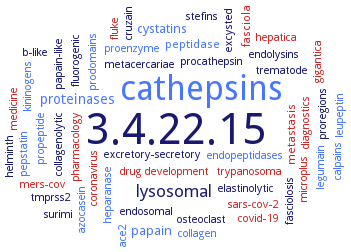3.4.22.15: cathepsin L
This is an abbreviated version!
For detailed information about cathepsin L, go to the full flat file.

Word Map on EC 3.4.22.15 
-
3.4.22.15
-
cathepsins
-
lysosomal
-
proteinases
-
cystatins
-
papain
-
metastasis
-
peptidase
-
fasciola
-
hepatica
-
fluorogenic
-
collagenolytic
-
pepstatin
-
trematode
-
tmprss2
-
metacercariae
-
stefins
-
medicine
-
endosomal
-
procathepsin
-
kininogens
-
endolysins
-
pharmacology
-
papain-like
-
fluke
-
b-like
-
covid-19
-
trypanosoma
-
mers-cov
-
leupeptin
-
calpains
-
proregions
-
excysted
-
azocasein
-
prodomains
-
osteoclast
-
coronavirus
-
fasciolosis
-
collagen
-
cruzain
-
drug development
-
excretory-secretory
-
ace2
-
heparanase
-
legumain
-
endopeptidases
-
sars-cov-2
-
elastinolytic
-
propeptide
-
gigantica
-
diagnostics
-
proenzyme
-
helminth
-
microplus
-
surimi
- 3.4.22.15
- cathepsins
- lysosomal
- proteinases
- cystatins
- papain
- metastasis
- peptidase
- fasciola
- hepatica
-
fluorogenic
-
collagenolytic
- pepstatin
-
trematode
- tmprss2
-
metacercariae
-
stefins
- medicine
- endosomal
-
procathepsin
- kininogens
- endolysins
- pharmacology
-
papain-like
- fluke
-
b-like
- covid-19
- trypanosoma
- mers-cov
- leupeptin
- calpains
-
proregions
-
excysted
- azocasein
- prodomains
- osteoclast
- coronavirus
-
fasciolosis
- collagen
- cruzain
- drug development
-
excretory-secretory
- ace2
- heparanase
- legumain
- endopeptidases
- sars-cov-2
-
elastinolytic
- propeptide
- gigantica
- diagnostics
- proenzyme
-
helminth
- microplus
-
surimi
Reaction
similar to that of papain. As compared to cathepsin B, cathepsin L exhibits higher activity towards protein substrates, but has little activity on Z-Arg-Arg-NHMec, and no peptidyl-dipeptidase activity =
Synonyms
AgCatL, Aldrichina grahami cysteine proteinase, cat L, Cat L-A, Cath L, cath-L, cathepsin L, cathepsin L isoform CRA-b, cathepsin L-A, cathepsin L-A1, cathepsin L-A2, cathepsin L-A3, cathepsin L-B, cathepsin L-like, cathepsin L-like cysteine protease, cathepsin L-like enzyme, cathepsin L-like protease, cathepsin L-like protein, cathepsin L-like proteinase, cathepsin L-like rCPB2.8, cathepsin L1, cathepsin L1H, cathepsin L3, cathepsin-L, cathepsin-L T2V, CathL, CatL, CATL A IV, CATL-1, CATL-2, CatL1G, CatL1H, CatL5, CL1, CL3, CL41.5, CPL, cpl-1, CsCPL, CsCPL-m, CtL, CTSL, CTSL1, CTSL2, Cwp84, FhCL1, FhCL3, Har-CatL, human cathepsin L, major excreted protein, MEP, PDP, progesterone-dependent protein, rhodesain, SMCL1, SoCatL, sperm-histone protease, TsolCL


 results (
results ( results (
results ( top
top






